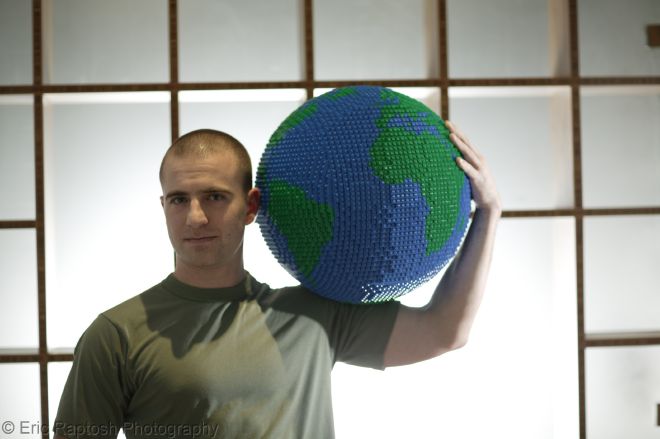|
David V. Winkler / sculpture / globe / | |

Imitation is the sincerest form of flattery. People that play with Lego long enough eventually build a globe. I understand that there is a globe on display at LegoLand. Eric Harshbarger built one. A while back BrickItGood had published plans for a studs-up globe. Then Eric Harshbarger posted to Lugnet about building a Lowell Sphere Globe. I thought it was the greatest thing ever. So I started work. Years and years ago I spent some time working with maps. So I got the Etopo5 data set, and set out to create plans for a similar globe. I used Bram Lambrecht’s sphere generator for the basic shape of the globe. I posted the results of my work. 
The I went on vacation to Mexico. I brought my laptop, and spent some downtime working on the plans. The software got better and the plans got better. I got home and I started building (after visiting BrickLink and buying lots of plates). I had origionally planned the globe using one 2434 (Brick, Modified 2 x 4 x 2 with Studs on Sides) (  ) per side per panel.
Then I tried putting the first three panels together.
I found that they didn’t hold together well enough.
So I redesigned the remaining three panels with 2 2434 pieces in each side.
The final panel I redesigned again after running out of green 1x3 plates ( ) per side per panel.
Then I tried putting the first three panels together.
I found that they didn’t hold together well enough.
So I redesigned the remaining three panels with 2 2434 pieces in each side.
The final panel I redesigned again after running out of green 1x3 plates ( ) and green 1x6 ( ) and green 1x6 ( ) plates. ) plates.
To assemble the globe I built the first five panels. I built the sixth panel up to the 2434 pieces. I assembled these first five and a half panels. I then built the second half of the sixth panel in place. The globe is bigger than I expected. It turns out that the globe is in general pretty strong, even without glue. I made the mistake of pushing on one of the pieces at the intersection of three panels. The piece fell into the middle of the sphere. Turning the globe upside down and shaking got the piece outside the sphere. Then I used a brick separator to get the piece back into place. When my friend Eric Raptosh visited Seattle he took pictures. Complete plans for the Lowell Globe are available on BrickShelf. I realized that I had all of the necessary components to be thorough with studs-up globe plans. I used the same data set to create studs-up step-by-step plans of globes of the world of radius 15-48 studs. (Below radius 15 the land masses didn’t show up well.) I did a bit more work and in November 2007 I posted plans for snot globes of radius 18-48 studs. At the suggestion of Bram Lambrecht I optimized the map rotation for each size globe to get the land masses to show up more accurately. |
|
Primary content in this document is © David V. Winkler. All other text, images, or trademarks in this document are the intellectual property of their respective owners. |
| |
©2005 LUGNET. All rights reserved. - hosted by steinbruch.info GbR |